FORD FOCUS ELECTRIC 2014 3.G Owners Manual
Manufacturer: FORD, Model Year: 2014, Model line: FOCUS ELECTRIC, Model: FORD FOCUS ELECTRIC 2014 3.GPages: 403, PDF Size: 6.42 MB
Page 211 of 403
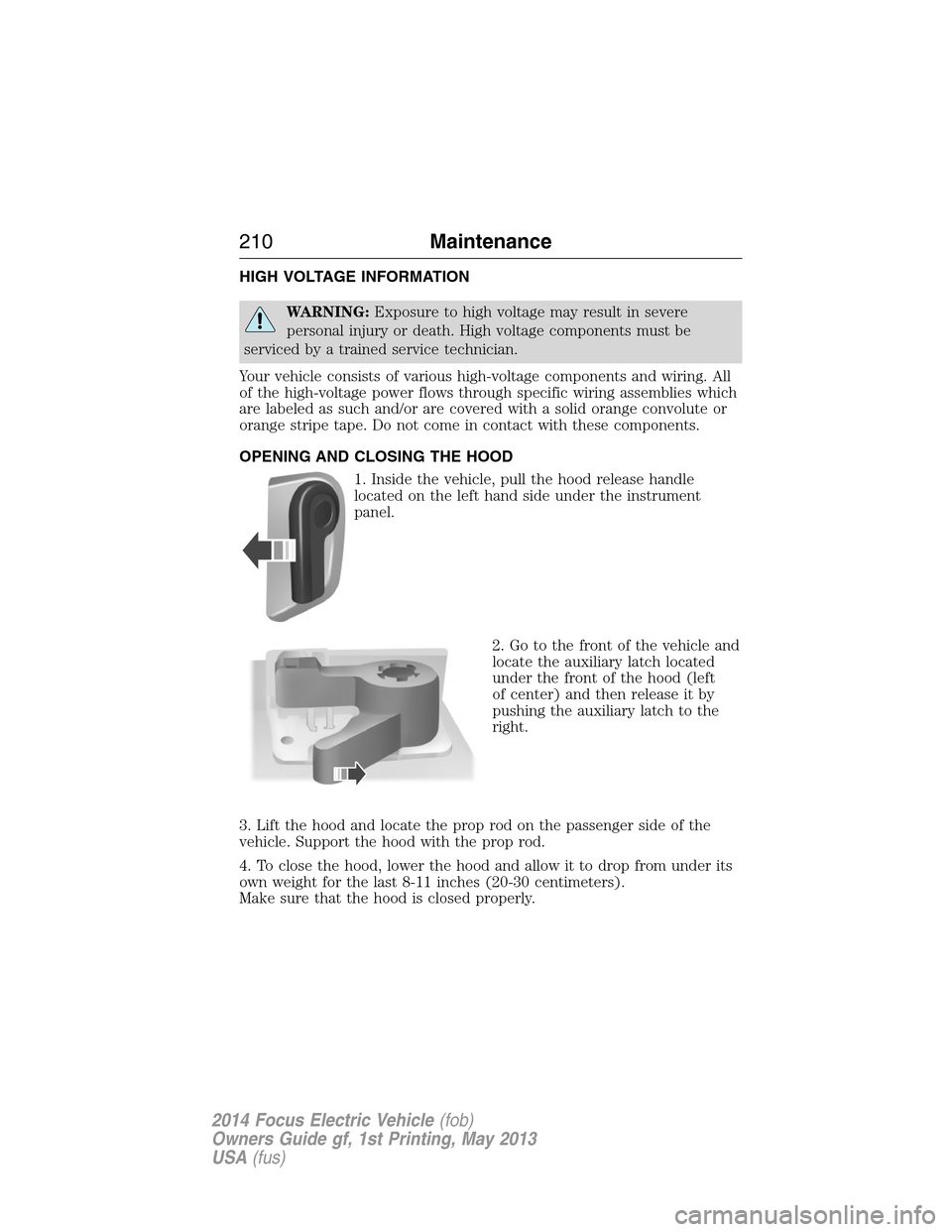
HIGH VOLTAGE INFORMATION
WARNING:Exposure to high voltage may result in severe
personal injury or death. High voltage components must be
serviced by a trained service technician.
Your vehicle consists of various high-voltage components and wiring. All
of the high-voltage power flows through specific wiring assemblies which
are labeled as such and/or are covered with a solid orange convolute or
orange stripe tape. Do not come in contact with these components.
OPENING AND CLOSING THE HOOD
1. Inside the vehicle, pull the hood release handle
located on the left hand side under the instrument
panel.
2. Go to the front of the vehicle and
locate the auxiliary latch located
under the front of the hood (left
of center) and then release it by
pushing the auxiliary latch to the
right.
3. Lift the hood and locate the prop rod on the passenger side of the
vehicle. Support the hood with the prop rod.
4. To close the hood, lower the hood and allow it to drop from under its
own weight for the last 8-11 inches (20-30 centimeters).
Make sure that the hood is closed properly.
210Maintenance
2014 Focus Electric Vehicle(fob)
Owners Guide gf, 1st Printing, May 2013
USA(fus)
Page 212 of 403
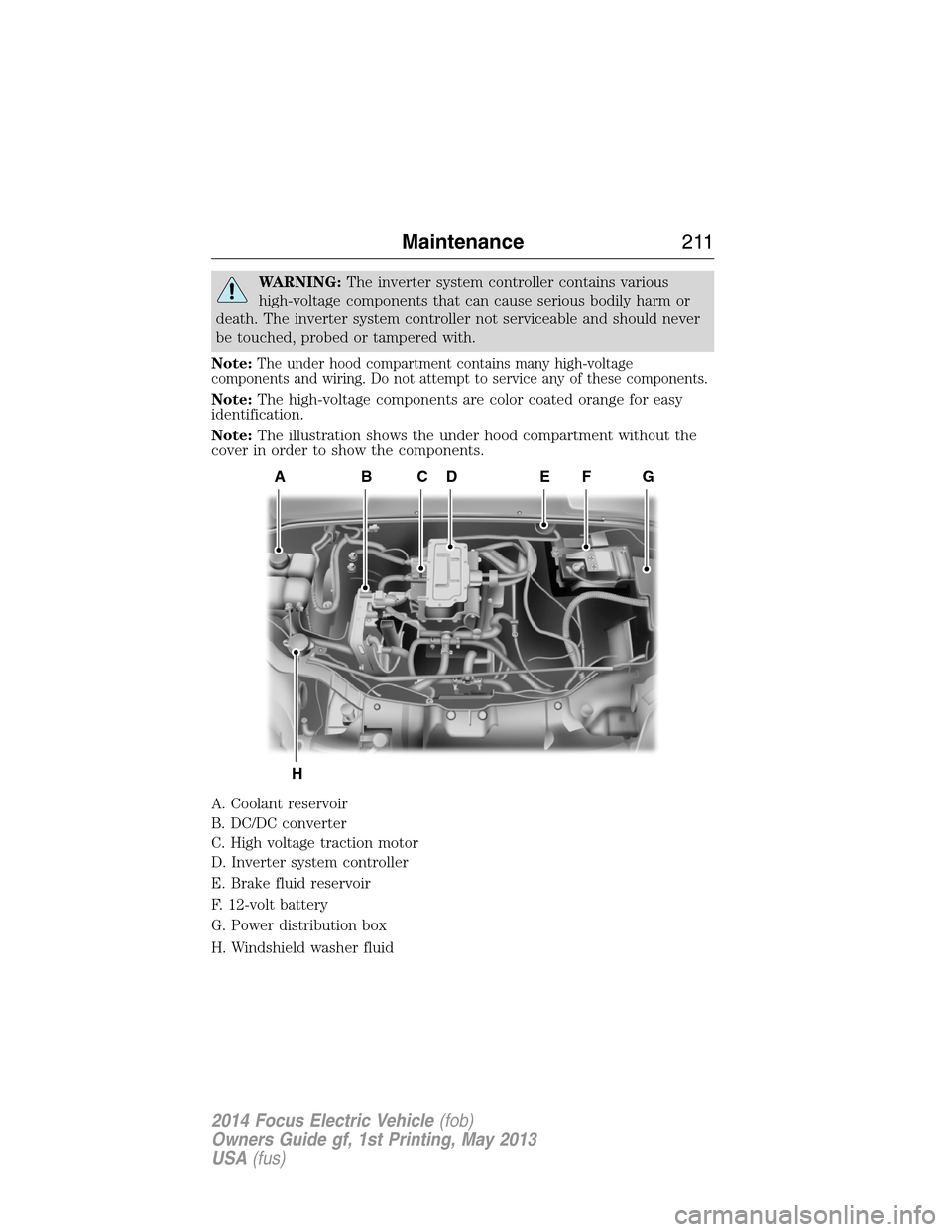
WARNING:The inverter system controller contains various
high-voltage components that can cause serious bodily harm or
death. The inverter system controller not serviceable and should never
be touched, probed or tampered with.
Note:
The under hood compartment contains many high-voltage
components and wiring. Do not attempt to service any of these components.
Note:The high-voltage components are color coated orange for easy
identification.
Note:The illustration shows the under hood compartment without the
cover in order to show the components.
A. Coolant reservoir
B. DC/DC converter
C. High voltage traction motor
D. Inverter system controller
E. Brake fluid reservoir
F. 12-volt battery
G. Power distribution box
H. Windshield washer fluid
A
H
BCDFEG
Maintenance211
2014 Focus Electric Vehicle(fob)
Owners Guide gf, 1st Printing, May 2013
USA(fus)
Page 213 of 403
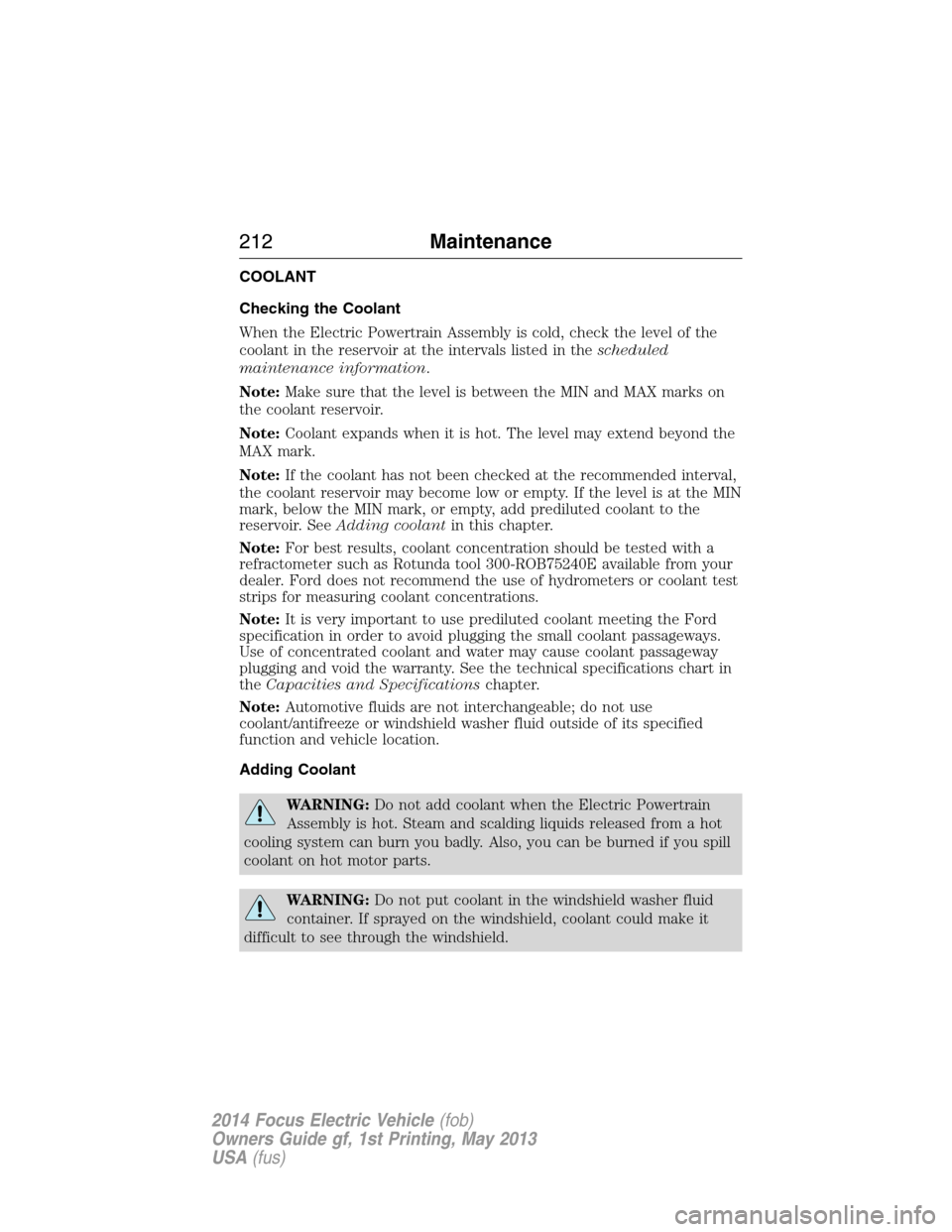
COOLANT
Checking the Coolant
When the Electric Powertrain Assembly is cold, check the level of the
coolant in the reservoir at the intervals listed in thescheduled
maintenance information.
Note:Make sure that the level is between the MIN and MAX marks on
the coolant reservoir.
Note:Coolant expands when it is hot. The level may extend beyond the
MAX mark.
Note:If the coolant has not been checked at the recommended interval,
the coolant reservoir may become low or empty. If the level is at the MIN
mark, below the MIN mark, or empty, add prediluted coolant to the
reservoir. SeeAdding coolantin this chapter.
Note:For best results, coolant concentration should be tested with a
refractometer such as Rotunda tool 300-ROB75240E available from your
dealer. Ford does not recommend the use of hydrometers or coolant test
strips for measuring coolant concentrations.
Note:It is very important to use prediluted coolant meeting the Ford
specification in order to avoid plugging the small coolant passageways.
Use of concentrated coolant and water may cause coolant passageway
plugging and void the warranty. See the technical specifications chart in
theCapacities and Specificationschapter.
Note:Automotive fluids are not interchangeable; do not use
coolant/antifreeze or windshield washer fluid outside of its specified
function and vehicle location.
Adding Coolant
WARNING:Do not add coolant when the Electric Powertrain
Assembly is hot. Steam and scalding liquids released from a hot
cooling system can burn you badly. Also, you can be burned if you spill
coolant on hot motor parts.
WARNING:Do not put coolant in the windshield washer fluid
container. If sprayed on the windshield, coolant could make it
difficult to see through the windshield.
212Maintenance
2014 Focus Electric Vehicle(fob)
Owners Guide gf, 1st Printing, May 2013
USA(fus)
Page 214 of 403
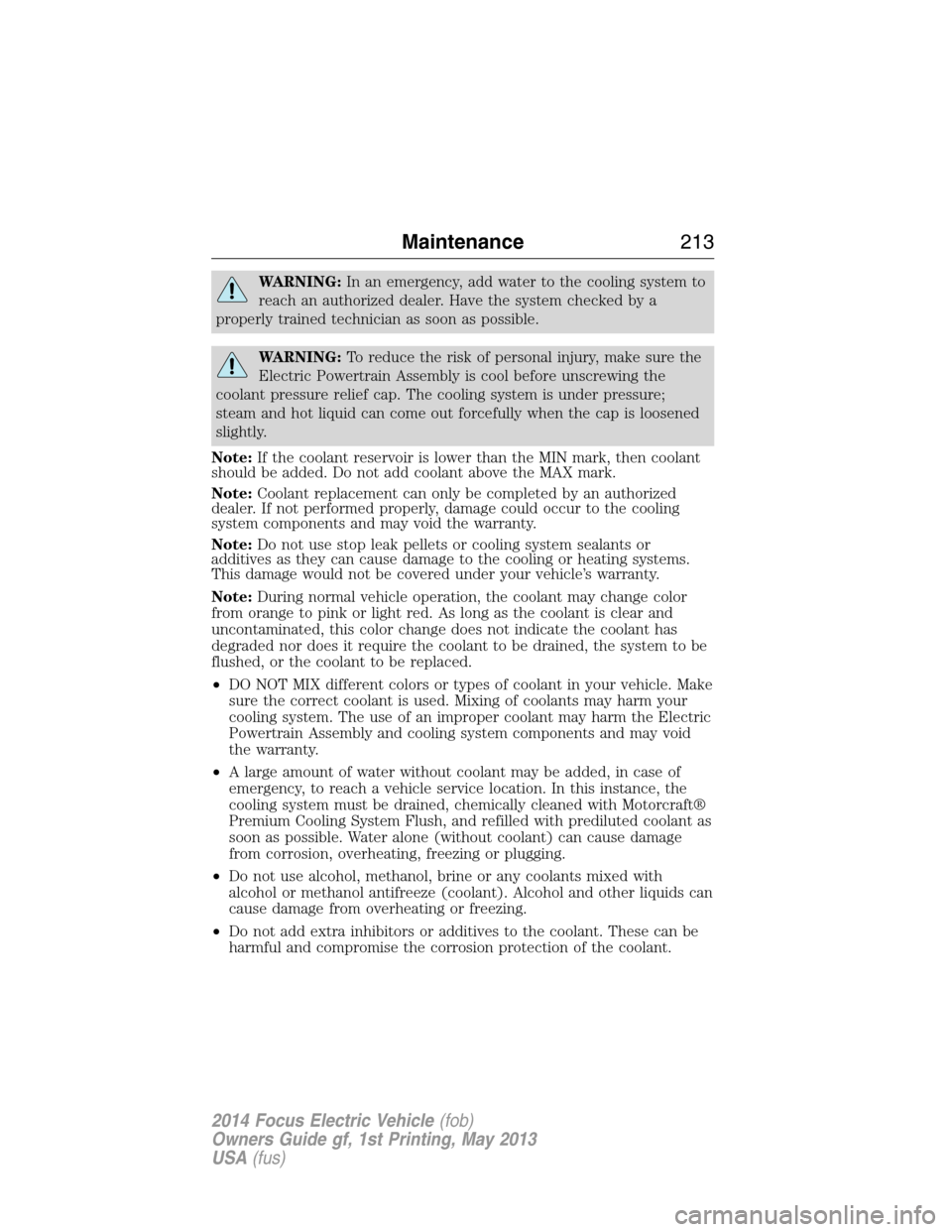
WARNING:In an emergency, add water to the cooling system to
reach an authorized dealer. Have the system checked by a
properly trained technician as soon as possible.
WARNING:To reduce the risk of personal injury, make sure the
Electric Powertrain Assembly is cool before unscrewing the
coolant pressure relief cap. The cooling system is under pressure;
steam and hot liquid can come out forcefully when the cap is loosened
slightly.
Note:If the coolant reservoir is lower than the MIN mark, then coolant
should be added. Do not add coolant above the MAX mark.
Note:Coolant replacement can only be completed by an authorized
dealer. If not performed properly, damage could occur to the cooling
system components and may void the warranty.
Note:Do not use stop leak pellets or cooling system sealants or
additives as they can cause damage to the cooling or heating systems.
This damage would not be covered under your vehicle’s warranty.
Note:During normal vehicle operation, the coolant may change color
from orange to pink or light red. As long as the coolant is clear and
uncontaminated, this color change does not indicate the coolant has
degraded nor does it require the coolant to be drained, the system to be
flushed, or the coolant to be replaced.
•DO NOT MIX different colors or types of coolant in your vehicle. Make
sure the correct coolant is used. Mixing of coolants may harm your
cooling system. The use of an improper coolant may harm the Electric
Powertrain Assembly and cooling system components and may void
the warranty.
•A large amount of water without coolant may be added, in case of
emergency, to reach a vehicle service location. In this instance, the
cooling system must be drained, chemically cleaned with Motorcraft®
Premium Cooling System Flush, and refilled with prediluted coolant as
soon as possible. Water alone (without coolant) can cause damage
from corrosion, overheating, freezing or plugging.
•Do not use alcohol, methanol, brine or any coolants mixed with
alcohol or methanol antifreeze (coolant). Alcohol and other liquids can
cause damage from overheating or freezing.
•Do not add extra inhibitors or additives to the coolant. These can be
harmful and compromise the corrosion protection of the coolant.
Maintenance213
2014 Focus Electric Vehicle(fob)
Owners Guide gf, 1st Printing, May 2013
USA(fus)
Page 215 of 403
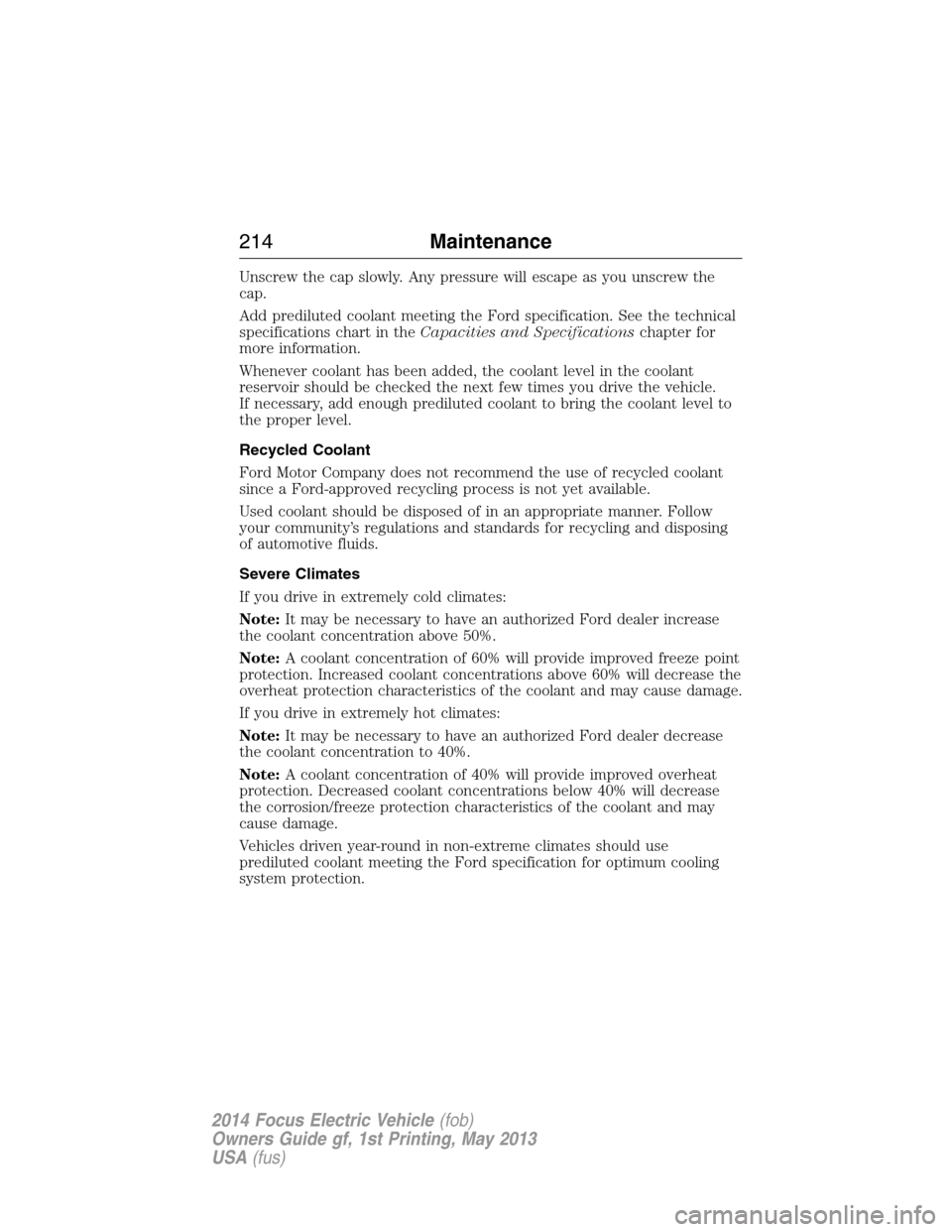
Unscrew the cap slowly. Any pressure will escape as you unscrew the
cap.
Add prediluted coolant meeting the Ford specification. See the technical
specifications chart in theCapacities and Specificationschapter for
more information.
Whenever coolant has been added, the coolant level in the coolant
reservoir should be checked the next few times you drive the vehicle.
If necessary, add enough prediluted coolant to bring the coolant level to
the proper level.
Recycled Coolant
Ford Motor Company does not recommend the use of recycled coolant
since a Ford-approved recycling process is not yet available.
Used coolant should be disposed of in an appropriate manner. Follow
your community’s regulations and standards for recycling and disposing
of automotive fluids.
Severe Climates
If you drive in extremely cold climates:
Note:It may be necessary to have an authorized Ford dealer increase
the coolant concentration above 50%.
Note:A coolant concentration of 60% will provide improved freeze point
protection. Increased coolant concentrations above 60% will decrease the
overheat protection characteristics of the coolant and may cause damage.
If you drive in extremely hot climates:
Note:It may be necessary to have an authorized Ford dealer decrease
the coolant concentration to 40%.
Note:A coolant concentration of 40% will provide improved overheat
protection. Decreased coolant concentrations below 40% will decrease
the corrosion/freeze protection characteristics of the coolant and may
cause damage.
Vehicles driven year-round in non-extreme climates should use
prediluted coolant meeting the Ford specification for optimum cooling
system protection.
214Maintenance
2014 Focus Electric Vehicle(fob)
Owners Guide gf, 1st Printing, May 2013
USA(fus)
Page 216 of 403
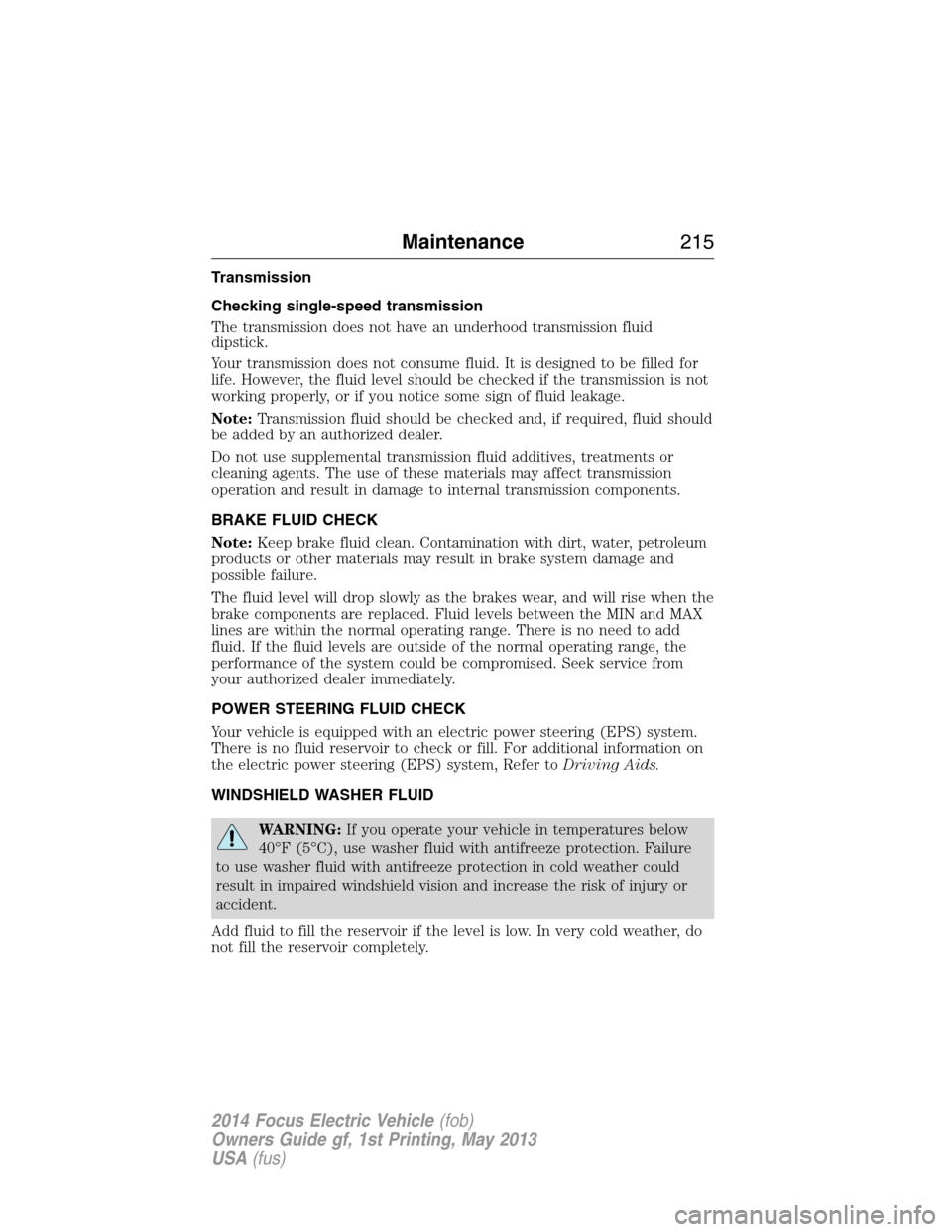
Transmission
Checking single-speed transmission
The transmission does not have an underhood transmission fluid
dipstick.
Your transmission does not consume fluid. It is designed to be filled for
life. However, the fluid level should be checked if the transmission is not
working properly, or if you notice some sign of fluid leakage.
Note:Transmission fluid should be checked and, if required, fluid should
be added by an authorized dealer.
Do not use supplemental transmission fluid additives, treatments or
cleaning agents. The use of these materials may affect transmission
operation and result in damage to internal transmission components.
BRAKE FLUID CHECK
Note:Keep brake fluid clean. Contamination with dirt, water, petroleum
products or other materials may result in brake system damage and
possible failure.
The fluid level will drop slowly as the brakes wear, and will rise when the
brake components are replaced. Fluid levels between the MIN and MAX
lines are within the normal operating range. There is no need to add
fluid. If the fluid levels are outside of the normal operating range, the
performance of the system could be compromised. Seek service from
your authorized dealer immediately.
POWER STEERING FLUID CHECK
Your vehicle is equipped with an electric power steering (EPS) system.
There is no fluid reservoir to check or fill. For additional information on
the electric power steering (EPS) system, Refer toDriving Aids.
WINDSHIELD WASHER FLUID
WARNING:If you operate your vehicle in temperatures below
40°F (5°C), use washer fluid with antifreeze protection. Failure
to use washer fluid with antifreeze protection in cold weather could
result in impaired windshield vision and increase the risk of injury or
accident.
Add fluid to fill the reservoir if the level is low. In very cold weather, do
not fill the reservoir completely.
Maintenance215
2014 Focus Electric Vehicle(fob)
Owners Guide gf, 1st Printing, May 2013
USA(fus)
Page 217 of 403
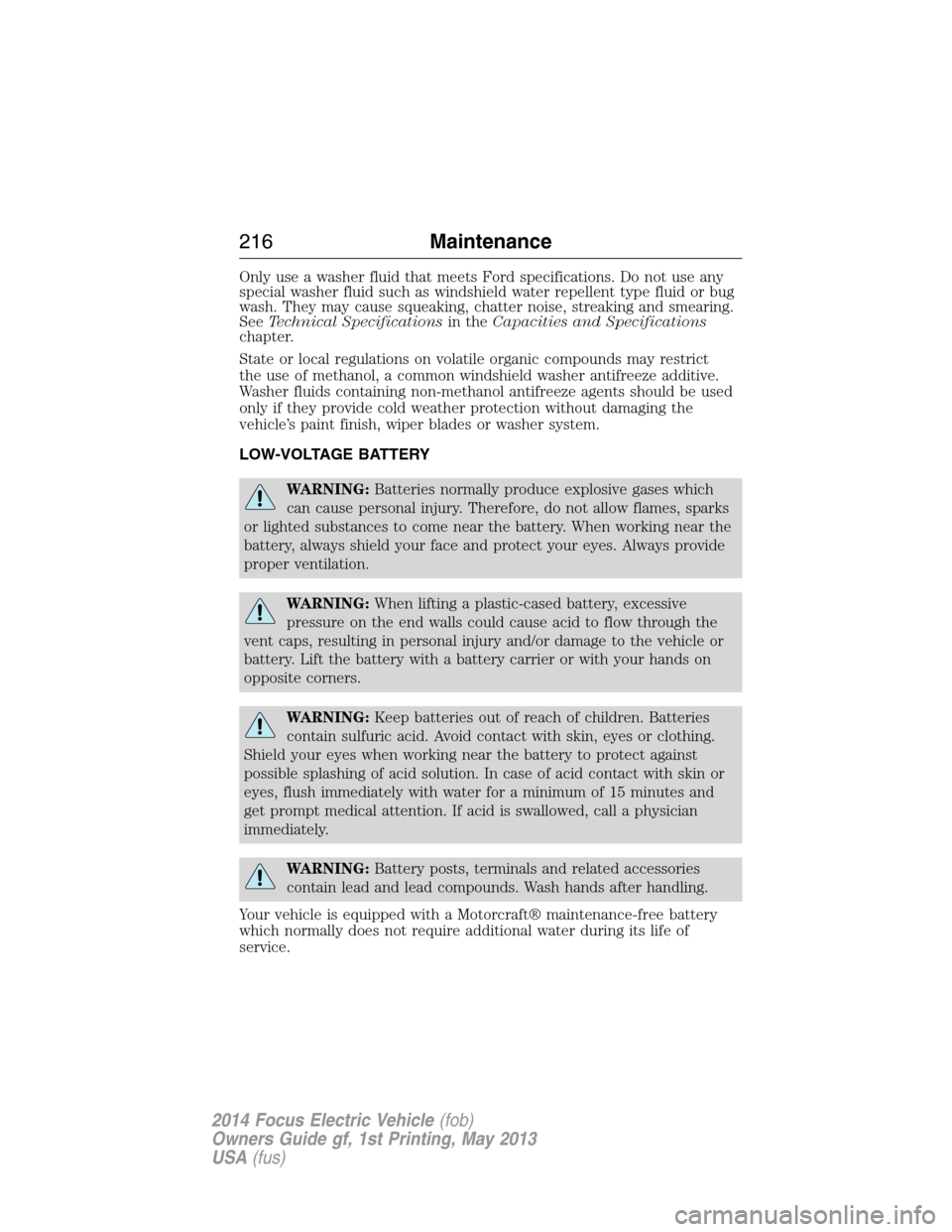
Only use a washer fluid that meets Ford specifications. Do not use any
special washer fluid such as windshield water repellent type fluid or bug
wash. They may cause squeaking, chatter noise, streaking and smearing.
SeeTechnical Specificationsin theCapacities and Specifications
chapter.
State or local regulations on volatile organic compounds may restrict
the use of methanol, a common windshield washer antifreeze additive.
Washer fluids containing non-methanol antifreeze agents should be used
only if they provide cold weather protection without damaging the
vehicle’s paint finish, wiper blades or washer system.
LOW-VOLTAGE BATTERY
WARNING:Batteries normally produce explosive gases which
can cause personal injury. Therefore, do not allow flames, sparks
or lighted substances to come near the battery. When working near the
battery, always shield your face and protect your eyes. Always provide
proper ventilation.
WARNING:When lifting a plastic-cased battery, excessive
pressure on the end walls could cause acid to flow through the
vent caps, resulting in personal injury and/or damage to the vehicle or
battery. Lift the battery with a battery carrier or with your hands on
opposite corners.
WARNING:Keep batteries out of reach of children. Batteries
contain sulfuric acid. Avoid contact with skin, eyes or clothing.
Shield your eyes when working near the battery to protect against
possible splashing of acid solution. In case of acid contact with skin or
eyes, flush immediately with water for a minimum of 15 minutes and
get prompt medical attention. If acid is swallowed, call a physician
immediately.
WARNING:Battery posts, terminals and related accessories
contain lead and lead compounds. Wash hands after handling.
Your vehicle is equipped with a Motorcraft® maintenance-free battery
which normally does not require additional water during its life of
service.
216Maintenance
2014 Focus Electric Vehicle(fob)
Owners Guide gf, 1st Printing, May 2013
USA(fus)
Page 218 of 403
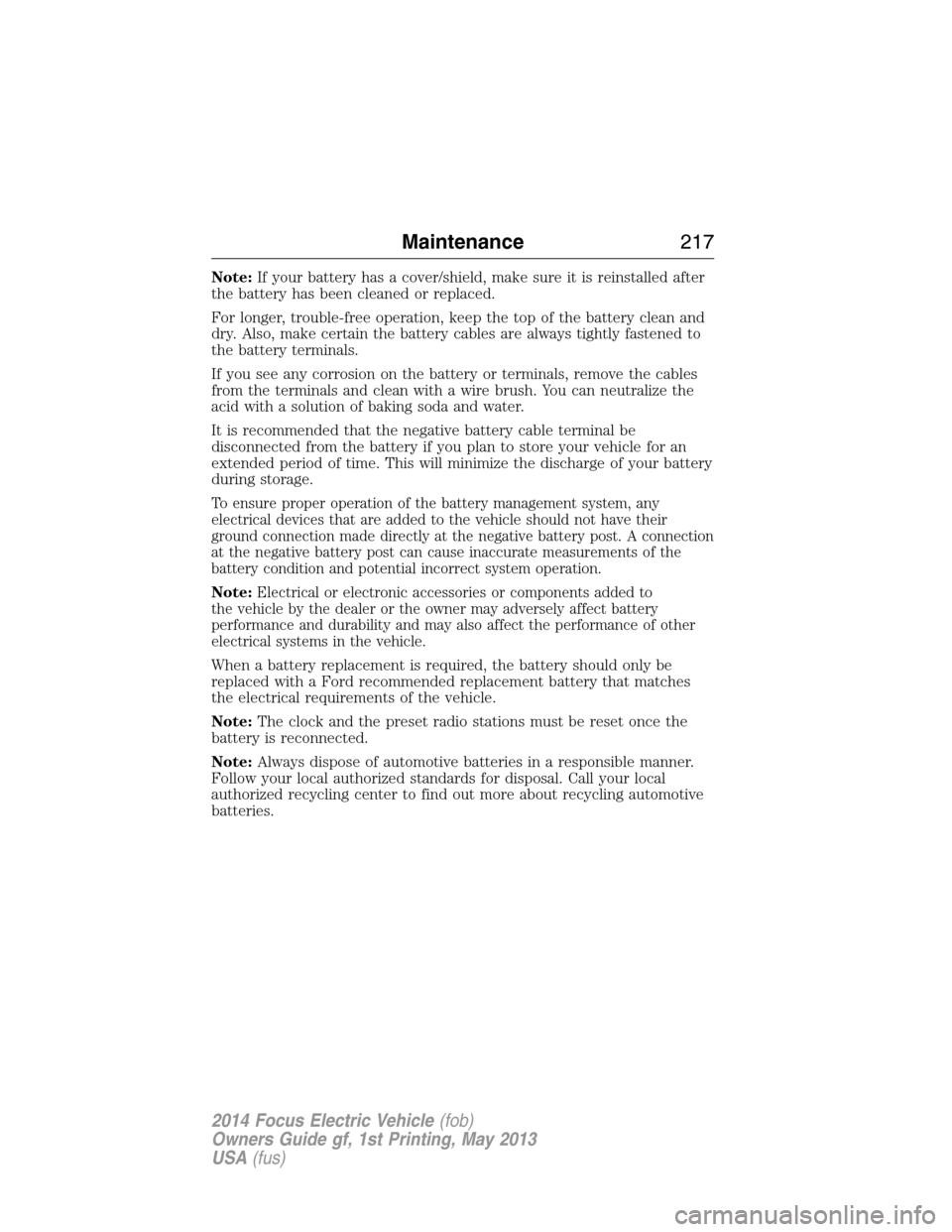
Note:If your battery has a cover/shield, make sure it is reinstalled after
the battery has been cleaned or replaced.
For longer, trouble-free operation, keep the top of the battery clean and
dry. Also, make certain the battery cables are always tightly fastened to
the battery terminals.
If you see any corrosion on the battery or terminals, remove the cables
from the terminals and clean with a wire brush. You can neutralize the
acid with a solution of baking soda and water.
It is recommended that the negative battery cable terminal be
disconnected from the battery if you plan to store your vehicle for an
extended period of time. This will minimize the discharge of your battery
during storage.
To ensure proper operation of the battery management system, any
electrical devices that are added to the vehicle should not have their
ground connection made directly at the negative battery post. A connection
at the negative battery post can cause inaccurate measurements of the
battery condition and potential incorrect system operation.
Note:Electrical or electronic accessories or components added to
the vehicle by the dealer or the owner may adversely affect battery
performance and durability and may also affect the performance of other
electrical systems in the vehicle.
When a battery replacement is required, the battery should only be
replaced with a Ford recommended replacement battery that matches
the electrical requirements of the vehicle.
Note:The clock and the preset radio stations must be reset once the
battery is reconnected.
Note:Always dispose of automotive batteries in a responsible manner.
Follow your local authorized standards for disposal. Call your local
authorized recycling center to find out more about recycling automotive
batteries.
Maintenance217
2014 Focus Electric Vehicle(fob)
Owners Guide gf, 1st Printing, May 2013
USA(fus)
Page 219 of 403
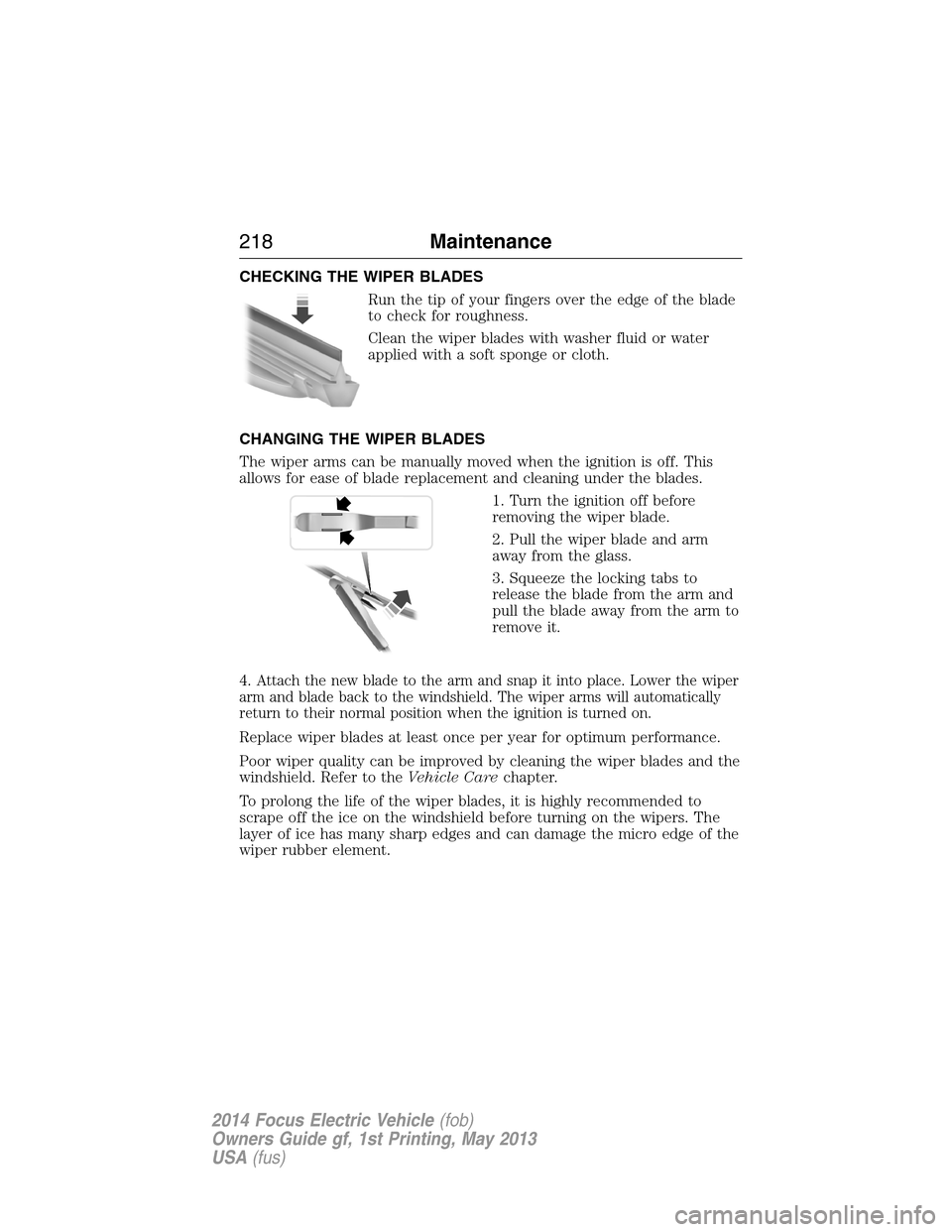
CHECKING THE WIPER BLADES
Run the tip of your fingers over the edge of the blade
to check for roughness.
Clean the wiper blades with washer fluid or water
applied with a soft sponge or cloth.
CHANGING THE WIPER BLADES
The wiper arms can be manually moved when the ignition is off. This
allows for ease of blade replacement and cleaning under the blades.
1. Turn the ignition off before
removing the wiper blade.
2. Pull the wiper blade and arm
away from the glass.
3. Squeeze the locking tabs to
release the blade from the arm and
pull the blade away from the arm to
remove it.
4.
Attach the new blade to the arm and snap it into place. Lower the wiper
arm and blade back to the windshield. The wiper arms will automatically
return to their normal position when the ignition is turned on.
Replace wiper blades at least once per year for optimum performance.
Poor wiper quality can be improved by cleaning the wiper blades and the
windshield. Refer to theVehicle Carechapter.
To prolong the life of the wiper blades, it is highly recommended to
scrape off the ice on the windshield before turning on the wipers. The
layer of ice has many sharp edges and can damage the micro edge of the
wiper rubber element.
218Maintenance
2014 Focus Electric Vehicle(fob)
Owners Guide gf, 1st Printing, May 2013
USA(fus)
Page 220 of 403
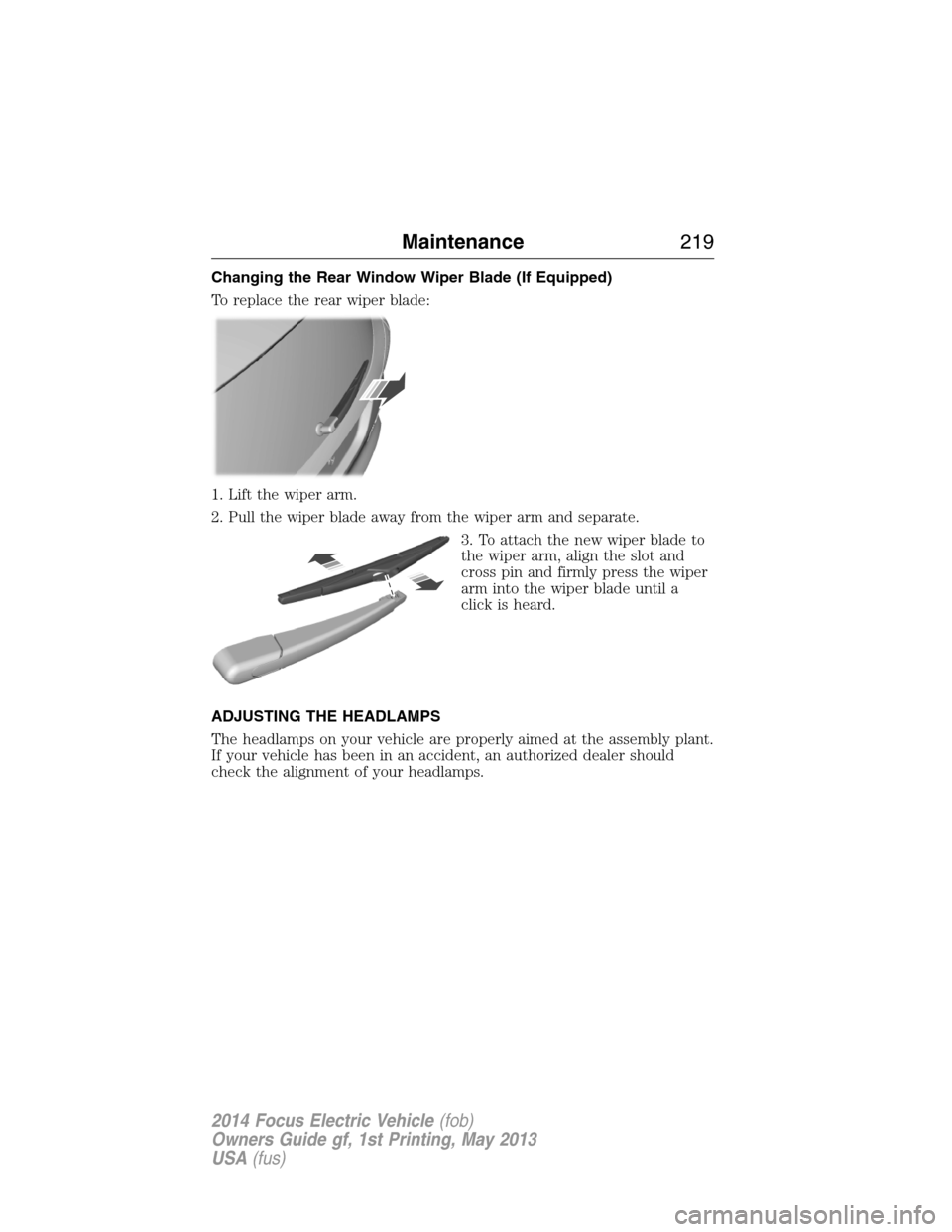
Changing the Rear Window Wiper Blade (If Equipped)
To replace the rear wiper blade:
1. Lift the wiper arm.
2. Pull the wiper blade away from the wiper arm and separate.
3. To attach the new wiper blade to
the wiper arm, align the slot and
cross pin and firmly press the wiper
arm into the wiper blade until a
click is heard.
ADJUSTING THE HEADLAMPS
The headlamps on your vehicle are properly aimed at the assembly plant.
If your vehicle has been in an accident, an authorized dealer should
check the alignment of your headlamps.
Maintenance219
2014 Focus Electric Vehicle(fob)
Owners Guide gf, 1st Printing, May 2013
USA(fus)